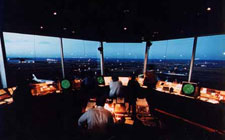 On Saturday I was scheduled to fly for a couple hours in a Citabria, but the weather got the best of things. Instead of worrying about punching through the 1,200 foot ceiling, I took the opportunity to visit the control tower at Reid Hillview Airport (no pictures allowed, thanks to TSA and/or FAA rules) with a few fellow student pilots (Mark and Lance).
On Saturday I was scheduled to fly for a couple hours in a Citabria, but the weather got the best of things. Instead of worrying about punching through the 1,200 foot ceiling, I took the opportunity to visit the control tower at Reid Hillview Airport (no pictures allowed, thanks to TSA and/or FAA rules) with a few fellow student pilots (Mark and Lance).
Getting there
I had called the tower before leaving the house so they'd know we wanted to come by. We had planned a tower visit even before the weather shot down most of the flying. They requested that I call again when we headed over. Doing so meant zero hassle when we arrived at the barbed wire topped security gate that leads to the tower parking area.
We parked, entered the building, and headed upstairs. There we found a couple controllers working the virtually dead traffic of the late Saturday morning. One was handling ground operations and weather. The other took care of folks on the runway and in the air. In addition to the desk and small kitchen appliances, they had mostly low-tech gear: radios, phones, paper, pen, etc.
The Gear
The most important item in the room, aside from maybe the radios, is "the board." I wish I could have taken a picture, but the board is a low-tech device where small movable plastic pieces are labeled for each aircraft. Their position on the board, along with the extra markings on them, tell any controller everything they need to know in a moment's glance: which planes are in the run-up area, who is in the pattern, etc. Well, this means any controller that knows the system they use at the Reid Hillview Tower, since it's not used by the rest of the FAA.
Their high-tech toys consisted of a computer, RADAR system, and a light gun. The computer is for accessing and updating weather information, which also had a bunch of cool reference material on it. For example, if a plane of a model they've never seen before calls in, they can look it up by name and see a nice picture of one. Then they can look out the windows (and they've got one hell of a view!) with their binoculars to verify that it's what they think it is.
They don't have on-site radar, but they do get a local feed from Moffett and a slightly less local feed from Oakland. Their display is customized with all the standard local reporting points, so if you call in "over UTC" or "over IBM" they can spot you in no time. One of the controllers asked a plane to switch transponder codes and identify (push the IDENT button) so we could see what that looks like on the screen. The visual appearance of the target changes in a fairly subtle way.
The light gun is probably something that non-pilots have never heard of before. It's a high-powered source of directed light that the tower can use to communicate with an aircraft whose radio has died. Different colors (red, white, green) mean different things on the ground and in the area. In reality they almost never use it. But their old light guns had problems, so the FAA game them a new high-tech battery powered model that I got to play with for a minute.
Listen for something that doesn't sound normal
We spent the majority of our hour or so up there listening to Steve talk about what goes on, how they work, their equipment, and answering our questions. We learned a lot about local traffic operations, how they assess pilot confidence over the radio (speak confidently and you'll get good treatment!), and other bits of trivia.
The most important advice we heard applies to both pilots and controllers. So much of aviation radio communication is scripted, routine, and expected that one should really be on the lookout for things that don't sound normal. When something doesn't sound quite right, ask for clarification or a repeat. It may have been a simple mistake. Or it may have simply been a problem with the transmission or reception.
And wouldn't you know it? I had such a thing happen to me earlier today. More on that later.
The Verdict
Every student pilot should take the opportunity to visit a control tower and get some quality time with the controllers. You'll learn a lot in a short amount of time. Probably the most important thing you'll learn, aside from the "listen for the abnormal" advice, is that controllers are people too. And they're there to help pilots.
Just like in other forms of technology medicated communication, it's all too easy to make assumptions about someone you've yet to meet in the real world.
Posted by jzawodn at January 22, 2006 09:04 PM | edit
i want to become a pilot only because of the lightgun :)
Years-ago it was part of pilot training to get a "light gun demo" which I thought neat (1964).
***************
Tim Mara told me you had a 304, neato. Sadly I'don't fit. Maybe some day we'll bump into each other.
Yes, I own 304C #62. I hope to get many more hours in the cockpit this season. :-)
The folks at the tower are great! :) They are very kind to student pilots, and I know the controllers do their best to make RHV a fun place to fly.
